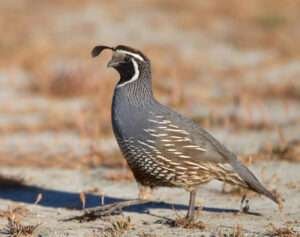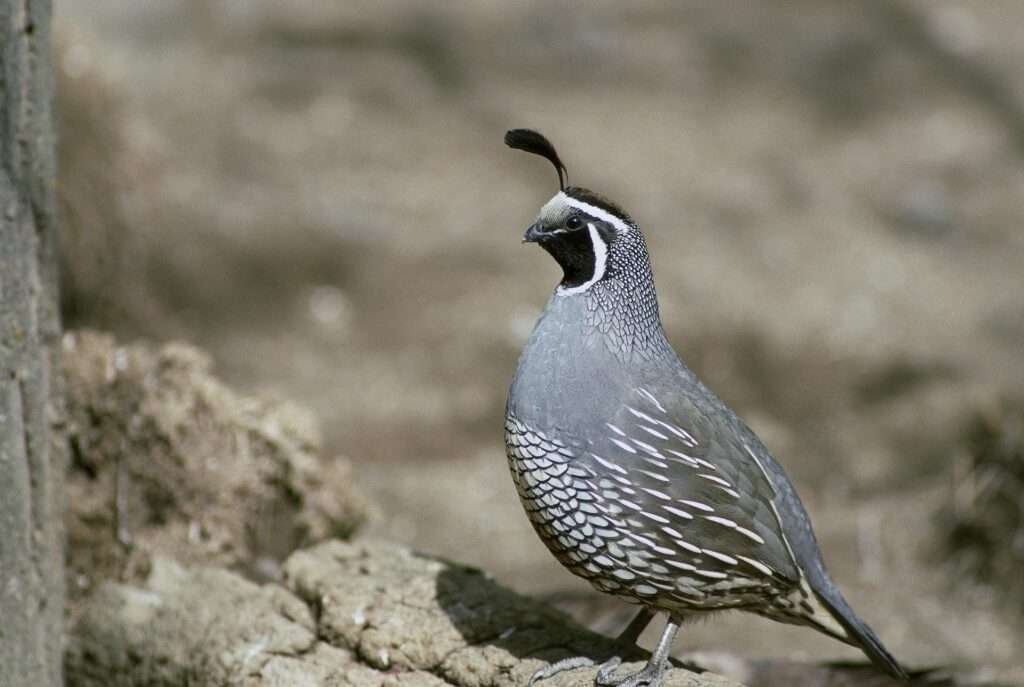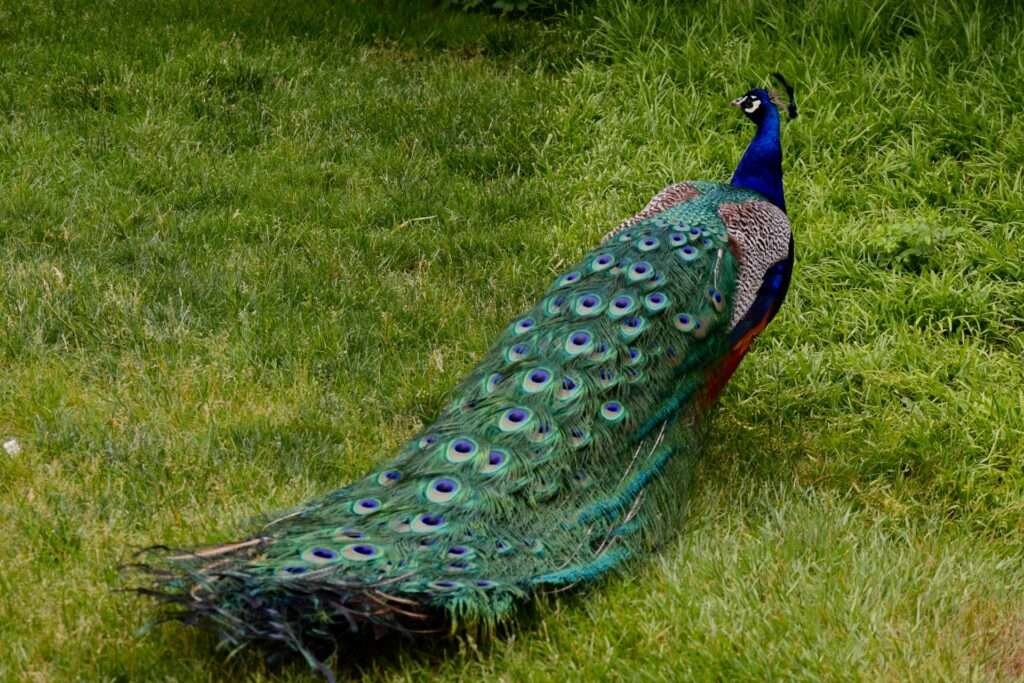The California Quail, known scientifically as Callipepla californica, is a small, plump bird native to the western United States. It is easily recognisable by its curved black plume and mottled brown plumage.
Endearing to birdwatchers, the California Quail boasts a distinctive call that echoes through its chaparral and scrubland habitats. It plays a significant cultural role as California’s state bird, symbolizing wildlife and natural beauty. Thriving in groups known as coveys, California quails exhibit strong family bonds and are often seen foraging together for seeds and insects.
This species’s adaptability to suburban areas demonstrates remarkable resilience despite habitat loss and predation pressures. Conservation efforts focus on maintaining the integrity of its natural environment, ensuring the quail continues to grace the Golden State with its presence.
Historical Background
Delving into the storied past of the California Quail reveals a rich tapestry of avian history endemic to the West Coast of the United States. Known scientifically as Callipepla California, this species has adapted to the diverse habitats of California and the surrounding regions, flourishing in brushlands, wooded areas, and suburban havens.
It is regarded as California’s state bird, embodying the resilience and splendour of the state’s natural world. Over the years, its signature topknot of feathers has become an iconic symbol, often depicted in local art and literature, illustrating the quail’s profound connection to the region’s cultural and environmental narrative.
These birds are admired by birdwatchers and nature enthusiasts and offer insight into the delicate balance of ecosystems, where they play a pivotal role.
Key Facts About the California State Bird
Embodying the essence of California’s avian diversity, the California Quail is a symbolic figure, designated as the state bird since 1931. Boasting a plump body and distinctive forward-facing head plume known as a topknot, this friendly bird is frequently spotted in small groups called coveys.
Adapted remarkably to life on the ground, these quails forage beneath shrubs and brush, making their presence known with a varied yet familiar repertoire of calls. Their stubby wings equip them for short bursts of flight, an admirable adaptation to their habitats ranging from coastal areas to foothills.
The male California Quail, with its striking facial markings and chestnut cap, not only adds a touch of beauty to the Californian landscape but also plays a vital role in local ecosystems, an example of nature’s intricate design.
How to Identify

Distinguishing the California Quail can be both delightful and intriguing. The forward-drooping plume on these birds’ heads easily distinguishes them. Notably, the male quail features a striking black face bordered with white alongside a brownish-grey body with a lighter belly sprinkled with black scallops.
Conversely, females show a more subdued colour palette, with a grey-brown tint and a lighter, scaled appearance without the facial markings. For wildlife enthusiasts, their distinctive ‘Chi-ca-go’ call is often a giveaway of their presence before they’re even spotted amidst the shrubbery.
These quails usually move in groups, known as coveys, enhancing their visibility for those eager to observe these charming creatures in their natural surroundings.
Sounds
People often describe the California Quail’s familiar sound as a sweet, descending “Chi-ca-go” call, which has become synonymous with the bird’s presence across varied habitats. Males are particularly vocal during mating season, using their calls to attract females and assert their territory.
These distinctive vocalisations can be heard throughout the day but are most prominent during the serene, early morning hours. Unique among the avian worlds, these calls are a means of communication and an audible signature of the species, resonating through the West Coast’s coastal sagebrush and chaparral environments.
The California Quail’s voice adds a charming layer to the natural soundscape, delighting bird watchers and nature enthusiasts.
What do they eat?
With their distinctive plume and rich grey bodies, California quails have a diverse palate that reflects their adaptable nature. These birds primarily forage on the ground, picking at seeds, which constitute the bulk of their diet, especially from California’s vast array of native plants.
In springtime, insects become a crucial source of protein, particularly for the growing chicks. Berries and other small fruits supplement their meals throughout various seasons, providing essential nutrients. This opportunistic approach to feeding marks the quails’ feeding habits, enabling them to thrive in the scrub, woodland, and grassland habitats they frequent.
Their dietary flexibility is fitting for a state as ecologically varied as California, ensuring these birds remain a resilient and familiar presence.
Typical Behaviours
Displaying a blend of curiosity and vigilance, California quails exhibit a fascinating array of behaviours that captivate bird enthusiasts. These plump birds often forage in groups or coveys, pecking at the ground in search of seeds and insects while keeping a watchful eye for predators.
Frequent communal dust baths, a delightful spectacle where these birds fluff and clean their feathers in unison, underscore their social nature. The distinctive ‘chi-ca-go’ call, often led by a male perched atop a vantage point, is a rallying cry that helps maintain group cohesion and alerts others to threats.
Despite their grounded appearance, they can burst into short, rapid flight when alarmed, using their strong legs to propel themselves skyward—a sudden yet effective escape strategy. These behaviours, among others, paint a vivid picture of California quail life, showcasing their adaptation to the diverse landscapes they inhabit.

Frequently Asked Questions on California Quail
What Is Special About the California Quail?
The California Quail, known for its distinctive plumed topknot, is California’s state bird and thrives in chaparral habitats. This species showcases complex social behaviours and adapts well to suburban environments.
Are California quails rare?
California quails are not unusual; they are widespread throughout their native range in the western United States.
Is it legal to own a California quail?
Owning a California Quail is generally legal but depends on state and local regulations. Always check with your state’s fish and wildlife agency to ensure compliance with specific laws and permits.
How many eggs does a California Quail lay?
California Quail typically lay between 12 and 16 eggs per clutch. Their nesting season spans from April to July, with the females responsible for incubation.
Conclusion
Embracing the charm of the California quail enriches our understanding of native wildlife. These birds symbolise adaptability and beauty across the Golden State’s diverse landscapes. Whether you’re a birdwatcher or a nature lover, the insights shared here can foster a deeper appreciation for these feathered friends.




